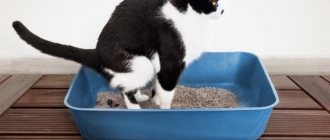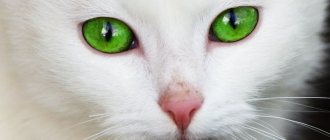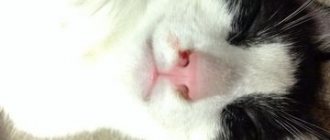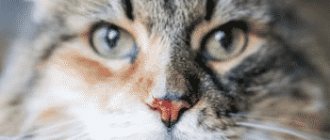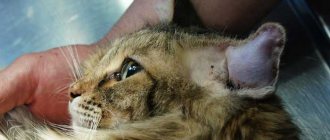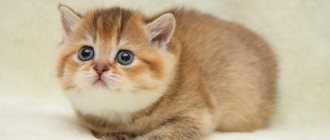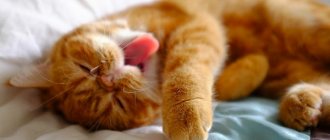The cat has pus flowing from his nose
If an animal has nasal discharge, then the pet urgently needs treatment.
Pus from a cat's nose can form due to allergies, a virus, or mechanical damage. You can find out what caused the snot from your veterinarian. Pus from the nose of a kitten or an adult cat can be of a different nature :
- Serous;
- Mucous;
- Mucopurulent;
- Purulent;
- Bloody;
- Bloody-purulent.
If a cat has pus flowing from its nose, which prevents it from breathing and changes its color to yellow or green, then the pet should be taken to the doctor immediately. Yellow discharge most often indicates a bacterial infection in your pet. If they have a yellowish tint, then the pet is infected with a viral infection.
Symptoms of rhinitis in cats
There are signs that will tell you that your furry pet is suffering from rhinitis. These include:
- Difficulty breathing. After active actions, running or playing, the animal's breathing becomes heavy. Swollen nasal passages do not allow sufficient oxygen to be received; the cat gasps for air.
- A state of detachment, indifference to everything around. The animal falls into apathy; games, entertainment and treats do not interest him.
- The cat is trying to put its nose in order on its own, scratching the diseased organ with its paw, moving it over furniture and other objects.
- The temperature may rise (up to 39 C), the cat’s nose becomes hot.
- Often a runny nose is accompanied by conjunctivitis, the cat's eyes swell, and pus collects in the corners.
- Nasal discharge.
The types of rhinitis vary, as does nasal discharge. The acute form of a runny nose is characterized by copious clear discharge. When a cat sneezes frequently and endlessly rubs its nose on furniture and other objects, there is reason to think about allergic rhinitis. If the cause of a runny nose is a viral infection, the discharge from the animal's nose will be the color of pus.
When rhinitis is caused by damage to the inner lining of the nose, the discharge is bloody and flows from only one nostril. With any type of rhinitis, crusts of dried discharge are visible under the animal’s nose.
Causes of purulent discharge
Pus is not only unpleasant, it can even interfere with breathing and swallowing. The cause of such discharge is nasopharyngeal polyps. This infection often appears in cats after treatment for inflammation of the middle ear and eustachian tube.
Discharge may appear due to neoplasms . Along with them, swelling appears, the muzzle begins to deform. Most often this happens to old animals suffering from adenocarcinoma, lymphosarcoma, fibrosarcoma, osteosarcoma.
Pus in a cat can be a symptom of a serious illness. The cause of purulent discharge may be :
- Mechanical damage to the nose with inflammation;
- Congenital pathologies such as cleft palate;
- Viral diseases (calcivirus infection or herpes);
- Toxoplasmosis;
- Entry of foreign bodies (for example, seeds);
- Panleukopenia or feline distemper;
- Chlamydial pneumonia.
If the cat has caught an infection, then discharge may also come from the eyes, the cat may sneeze and hide in a corner. You can take your temperature: if you are sick, it will be elevated.
Pus is much more serious than clear discharge and is never caused by a common cold. The disease is much more serious than a simple runny nose, and therefore you should consult a doctor. He will prescribe the right medications and dosage for your cat.
In kittens, discharge may occur for other reasons. Pus can appear from hypothermia, poor nutrition and living conditions, lack of care or early separation from the mother cat.
Treatment of pus
Before going to the veterinarian, you can provide first aid to the animal yourself. You can help an animal that has contracted an infection by doing the following:
You can rinse your nose from pus with solutions of boric acid (2%), zinc sulfate (1%), and saline solution. They can also be used to soak crusts. ;
Instillation of antiviral drops: Gamavit, Vilprofen, Maksidin, Thymogen, Anandin. You can also use baby drops, but only for one time. They eliminate only the symptoms (constrict blood vessels), without interacting with viruses and bacteria;
The use of different widow drops: antiviral and immunostimulating. There should be 2 hours between using drops of the same type.
Treatment
Since a runny nose often becomes only an indicator of a viral infection or other inflammation in the body, it will be necessary to treat not so much it as the root cause. It is not always possible to independently find out the true source of the disease. Therefore, it is very important to consult a veterinarian, conduct a diagnosis and follow the treatment plan.
It will be very difficult to cure a stray cat from a runny nose if he is not provided with comfortable conditions: warmth, food, vitamins and scheduled medications.
Useful video on how to put drops in a cat's nose:
Colds and rhinitis
If your cat's cold cannot be treated at home, then you need to seek help from a veterinarian. The clinic will examine the cat and prescribe the necessary medications. It is not recommended to use medications without a prescription from a specialist. Typically treatment includes:
- Taking antipyretics if the temperature persists.
- Expectorants.
- Antibiotics.
- Vitamins.
- Droppers (to avoid dehydration).
- Maxidin. Drop into the nose to stimulate the immune system.
- Anandin. Antiviral and immune system stimulant.
- Naphthyzin together with Dioxidine. Nasal rinsing.
- Galazolin. Drops to ease breathing.
One drop of the drug is instilled into each nostril. The course is from five days to a week. You can rinse your nose with zinc sulfate (2%), boric acid (3%), a mixture of Methanol and fish oil.
Other means: “Maksidin”, “Derinat”.
Important! Never use “human” drops, they can aggravate the situation and cause irritation of the mucous membrane.
Allergic runny nose
Irritation in animals is caused by food and non-food allergens. The most common of them:
- Beef or pork.
- Chicken, chicken eggs.
- Cow's milk.
- Corn, wheat (other cereal grains).
- Potato.
- Carrot.
- Dust.
- Mold.
- Hygiene products, household chemicals.
- Irritant from a flea collar.
To cure an allergy, you need to accurately and in detail describe the symptoms to the doctor; it is advisable to note what exactly the cat reacts to and for how long. They do a blood test and scraping. Antihistamines and corticosteroids are most often used for treatment.
The house needs to be treated with insecticides, and the animal must be isolated from the allergen that causes the reaction. If you cannot immediately find out what exactly is causing the disorder, you must remove as much as possible all household chemicals, medications, cosmetics, etc. The room must be cleaned and ventilated frequently.
If the allergy is accompanied by itching, the doctor will prescribe a special ointment, shampoo or gel. Sometimes steroid hormones and immunotherapy are prescribed (a small amount of the allergen is injected into the blood so that the body gets used to it).
If you have an eating disorder, you need to follow a diet. For example, use hypoallergenic food. When the symptoms go away, the previous foods are returned to the diet, checking the animal’s reaction. If the runny nose recurs, food allergens should be categorically removed from the animal’s food forever.
Viral runny nose
Among viral infections, rhinotracheitis, calicivirosis, mycoplasmosis, chlamydia and other infections cause a runny nose. And although they differ, the treatment regimen is approximately the same for everyone. The main thing is to contact specialists in time. You cannot cure a viral infection on your own; only a veterinarian can prescribe the exact dosage and duration.
Serum or globulin is used to create immunity - the drug VITAFEL, vitamins and probiotics, replacement therapy.
Antibiotics are required. They are drunk for at least five days, most often from a week to ten days, one to three times a day.
Treatment at home
For treatment at home, nasal drops are used, for example, children's nasal drops - one in each nostril daily. You can rinse your nose with a hypotonic solution: a teaspoon of sea salt in warm water (half a glass). The mucous membrane is also washed with a solution of tannin (0.5%), soda (1% solution). Streptocide powder is blown into the nasal cavity or two drops of ecmonovocillin are dripped into each nostril (it is diluted with saline 1:2).
From folk remedies, rinsing with beet juice is suitable: 1 part juice to 3 parts water. Aloe juice from the cut is collected into a pipette and dripped for three days. To rinse, you can use boric acid (draw the liquid into a syringe without a needle, drop it into the nostril).
You can do inhalation: take a bowl of hot water, drop eucalyptus or other oil into it, and place the container near the animal.
How to put it in your nose correctly
If the veterinarian prescribes treatment, then it is the owner who should administer the drops into the cat’s nose. This should be done in the following sequence :
- Hold your pet under your armpit or have someone hold it. You can wrap it in a blanket so that the animal does not scratch anyone;
- Throw back the animal's head, tilt it slightly;
- Carefully bring the dispenser to the muzzle;
- Wait until the drops flow back, tilt your head in the other direction and repeat the same actions.
You need to instill one, maximum two drops. The animal is treated in this way for a week, but if the infection is viral, it will take longer.
How to treat a runny nose in a cat
The choice of treatment method must be entrusted to a professional after the main diagnosis has been established. If the cause is not related to a cold, but to some other disease, it is necessary to cure this disease - after this the runny nose will disappear.
For bacterial infections, Baytrodil or Amoxiclav may be prescribed. Viral infections are treated with drugs: Neoferon, Vitafel, Giscan, etc. Fungal pathologies are treated with Fluconazole and Intraconazole.
The following medications are used to treat colds:
- Maksidin – nasal drops, immunostimulant;
- Anandin is an antiviral immunostimulating agent;
- Naphthyzin in half with Dioxidine - you can rinse your nose with this solution;
- Halozolin is a children's nasal drop that relieves difficulty breathing.
Medicines are administered into each nostril, 1 drop. Treatment can be continued for 5-7 days.
Folk remedies
If you can’t see a veterinarian, but you need to treat your cat for a cold, you can use the following recommendations. These are well-tested folk remedies that experienced breeders and veterinarians recommend using at home:
- Warming the nasal sinuses with warm salt or river sand. It is convenient to put salt and sand in a small bag or baby sock.
- A cat's snot can be cured by dropping aloe or beetroot juice into the nose.
- Rinse the nose with Aqua Maris, furatsilin or gramicidin.
- You can blow streptocide powder into each nostril - this will relieve inflammation and swelling.
- Inhalations with eucalyptus or Zvezdochka balm.
- Rinse the nose, eyes and ears with green tea.
Excessive snot in a kitten or adult cat leads to irritation of the skin of the nose. Therefore, you need to dry the skin using streptocide powder.
Important : do not ignore a runny nose; if left untreated, it can develop into a chronic one.
In order for your cat to recover faster, it is important not only to follow all the doctor’s recommendations, you need to give her the most comfortable and warm place in the apartment, provide her with adequate nutrition, and give her vitamins. During illness, a cat needs more love and care from its owner.
Determining the cause of the leak
A veterinarian can determine why a cat’s nose is festering. It will determine the nature of the discharge. If the doctor suspects polyps or neoplasms in the nose, the pet may be sent for rhinoscopy (x-ray of the nose). It is there that the nature of the neoplasms is revealed.
Pus is a sufficiently alarming signal to contact a veterinarian. Rhinitis in humans can be cured on their own, while a cat with pus coming from the nose can only be treated by a veterinarian. Only an experienced veterinarian will be able to determine the correct dosage of medication and prescribe the correct medications to treat the problem.
Source
Causes of snot
Cats are very sensitive to their environment. You can catch a runny nose anywhere. It is important at the first stage to identify where it came from - is it a common cold or a symptom of another serious illness. To save an animal from this scourge, it is necessary to look for the source of its occurrence.
Causes of snot:
- fungal infections - such bacteria most often do not cause significant harm to the cat. The discharge is rare and clean. In the acute form of the virus, discharge becomes more frequent, crusts form, and the nasal cavity becomes clogged. This disease is treated with targeted medications. Ordinary drops can lead to complications of the condition.
- viruses - in this case, in addition to snot, problems with the gastrointestinal tract, sneezing, and pus in the eyes are added. Treatment is carried out comprehensively, only by a veterinarian, because there is no cure for many cat viruses. Timely vaccination will save your pet; it must be done regularly.
- allergies - here any new item that appears in the house can cause snot: household chemicals, shampoo, new litter for the tray, food, plant - any irritant, except distilled water, can lead to an allergic reaction. Watery eyes, excessive nasal discharge, rapid breathing, itching are the main signs of this problem in a cat.
- chronic illnesses - here the cause of snot is any disease. Due to the body's low resistance, the cat becomes susceptible to any changes.
- inflammation of the ear - the nasal mucosa is more delicate than the ear, and therefore more susceptible. Discharge in the sinuses is a consequence of ear problems. In this case, ear diseases are treated first, then rhinitis.
- long exposure to the cold - what to do when a cat has snot from hypothermia? Warm her up in a blanket and move a heating pad to her limbs. It is forbidden to give any alcohol-containing substances inside or to immerse the animal in hot water. Such actions will lead to the cessation of heart function and respiratory arrest.
- neoplasms - cause the appearance of thick snot with blood. Rhinitis becomes chronic. The cat constantly sneezes, fidgets with its nostrils, and some deformation of the face occurs. Most often, tumor diseases affect animals older than seven years, however, this also occurs in young animals.
- foreign bodies - a blade of grass, a seed, a speck of dust, a fragment of a claw, sand - the presence of any small object in the nasal sinuses will explain why the cat’s snot does not stop flowing. If what is inside the nostril is visible, the owner can remove it himself. After completion of the procedure, regenerating drops are dripped for 7 days.
- congenital pathologies - this item includes deformations and all kinds of curvatures. They also arise in the process of injury (strike, fight). The discharge is cloudy, thick, and ulcers appear. Treated with surgery.
- parasites - small pests (ticks, fleas, worms) cause various causes of a runny nose.
If your cat has green snot and thick discharge, these are symptoms of advanced rhinitis, an acute stage of the disease. A veterinarian will help your pet cope with the disease without health complications. It is not the runny nose itself that is treated. You need to get rid of the disease that provoked it. Only a specialist can identify it.
© shutterstock
Purulent nasal discharge in a cat is a possible cause of the pathology.
The development of rhinitis in cats is a kind of protective reaction of the body, aimed at quickly ridding the nasal passages of possible allergens or pathogenic microorganisms.
Discharge of exudate from the nasal passages is often accompanied by sneezing and difficulty breathing. The pet tries to open its mouth in order to inhale more air, while the mucous membrane of the oral cavity begins to dry out, adding new discomfort to the animal.
Purulent rhinitis in cats is diagnosed quite often and can be evidence of an infectious disease or a sign of a pathological process that develops as a result of a congenital anomaly.
The appearance of pus from the nasal passages of a pet is a reason to immediately seek help from a veterinarian. This will prevent serious complications that can threaten not only the health, but also the life of the cat.
Before taking measures to eliminate purulent exudate from the nose in cats, it is necessary to establish the exact cause of the pathological condition.
Possible diseases characterized by purulent nasal discharge
Purulent nasal discharge in a cat is not the main disease, but only a signal from the body about the development of pathology.
Purulent exudate is not only unpleasant in appearance and has a repulsive odor, but also seriously impairs breathing and can also interfere with the act of swallowing.
Veterinary specialists often diagnose the appearance of pus from the nose associated with an infection that has caused an inflammatory process in the middle ear or eustachian tube.
Pus may appear from the nose of a pet due to malignant neoplasms in the nasal passages. Pus is diagnosed in the last stages of lymphosarcoma, fibroxarcoma, osteosarcoma, adenocarcinoma. In addition, the causes of pus from a cat’s nose can be:
- injuries to the back of the nose and nasal passages of the mechanical type (due to impacts or a stuck foreign body in the upper part of the respiratory tract);
- abnormalities of intrauterine development (cleft palate or cleft lip, deviated nasal septum);
- infectious diseases (viral infections);
- toxoplasmosis and chlamydial pneumonia.
In the vast majority of clinical cases with viral respiratory infections, not only nasal discharge is observed. For example, with a herpes virus infection, discharge from the eyes and nose in cats is observed. Statistics say that 85% of all reported cases of purulent exudate from the nasal passages are due to a cat becoming infected with a calcivirus infection. Feline viral rhinotracheitis can damage the upper respiratory tract, as well as the eyes and mouth. The symptoms of the disease are unusually similar to the influenza virus, since with calcivirus, dyspeptic disorders and pulmonary dysfunction develop. Kittens and cats without immunization are susceptible to infection. At risk are cats with viral immunodeficiency and feline leukemia, as well as pets with chronic diseases of internal organs.
Another dangerous disease that affects the cat’s body is cryptococcosis. This is an infection caused by fungal microorganisms found in the environment. It is characterized by damage to the upper part of the respiratory tract, inflammatory processes in the area of the pulmonary structures and the labyrinth of the nose. It is possible for a fungal infection to spread to the eye area, under the skin and penetration into the central brain. Fortunately for owners, cryptococcosis is diagnosed less often in cats than in other domestic animals.
In cats of the British breed and Scottish Fold, structural pathologies in the form of stenosis of the nostrils are often diagnosed. A congenital anomaly is the cleft lip, which is one of the factors in the occurrence of purulent discharge from the nasal passages. The causes of purulent discharge are toxoplasmosis and chlamydia in the acute stage of the course. Chlamydial infection can be transmitted through discharge from a sick animal to a healthy one. Transmission of the pathogen is also possible through contact of an animal with feces or urine of a sick cat. Pregnant cats can transmit chlamydia to unborn kittens when they pass through the birth canal. In addition to rhinitis, chlamydia leads to serious damage to the mucous membrane of the eyes and conjunctival sac. The organs of the respiratory system, digestive tract and urinary system are affected.
Symptoms
Depending on the cause, nasal discharge during a runny nose in a cat has a different consistency.
When you have a cold, the discharge is clear, there is lacrimation, and conjunctivitis. The temperature rises, the nose becomes dry and hot. The cat is lethargic and loses its appetite.
Red vomit in a cat
Causes of cough in cats
The cat is vomiting bile, what should I do?
Allergic reactions and viral diseases are accompanied by copious, liquid, colorless exudate.
In infections of a bacterial nature, a runny nose in the form of thick, yellow-green discharge with an unpleasant odor. The cat breathes through its mouth, wheezing and snoring can be heard in its sleep.
A foreign body entering a cat's nose is accompanied by profuse salivation and frequent swallowing. Usually the body gets rid of a foreign object on its own, sometimes the help of a specialist is required.
The parasitic lesion is manifested by the cat's anxiety: the animal sneezes, shakes its head, rubs its head on objects. Swelling of the lymph nodes is observed.
Chronic rhinitis has a wave-like course with exacerbations and periods of remission. Liquid discharge gives way to thick discharge with the formation of dark crusts.
Acute viral diseases accompanied by a runny nose are especially dangerous.
Rhinotracheitis (cat flu) is caused by the herpes virus GVK-1. Highly contagious, contagious to humans. Characterized by high fever, purulent discharge from the nose and eyes, and inflammation of the cornea. The disease is accompanied by drooling, malaise, and lack of appetite.
Calcivirosis is a contagious viral disease transmitted by airborne droplets. Manifestations: high fever, runny nose, mouth ulcers. In adult cats, it sometimes occurs in a latent form, with lethargy and loss of appetite. Often develops into pneumonia or becomes chronic.
Panleukopenia is a disease of viral etiology that affects the gastrointestinal tract. The virus is resilient and persists for up to a year in the external environment. Rapid course of the disease: depressed state, temperature up to 40˚C, runny nose, lacrimation, salivation, constipation or diarrhea.
Diagnosis and treatment
The appearance of purulent discharge in a pet means that the owner should immediately contact a veterinary clinic. It is not recommended to prescribe treatment on your own, since without specific diagnostic methods, feasible only in a hospital setting, it is not possible to prescribe adequate therapy. At an appointment with a veterinarian, the animal undergoes a clinical examination and laboratory tests. The basis of diagnosis is the determination of the qualitative composition of the exudate. Cytology can identify a fungal infection or viral agents. A sample of purulent discharge is also taken for analysis and further bacterial culture. After identifying the causative agent of the disease, the specialist draws up an individual treatment regimen.
Prevention
Preventive measures to prevent the development of purulent rhinitis involve regular examinations by veterinary specialists. This allows you to promptly identify possible anomalies in the structure of the nasal septum or other pathologies. At the slightest sign of your pet's ill health, you should contact a veterinarian for advice.
The development of dangerous viral diseases accompanied by profuse purulent discharge from the nose can be prevented by timely immunization of the cat. The necessary criterion is proper nutrition and maintaining the body’s defenses at the proper level.
Source
Causes
Diseases in which pus is discharged from the nose are divided into contagious and non-contagious.
The following are considered contagious:
- Herpes (rinotracheitis);
- Calicivirus;
- Cat flu;
Among the diseases of non-contagious etiology, the following most often develop:
- chronic diseases and colds;
- foreign bodies;
- congenital anomalies;
- tumors.
The causes of diseases, clinical symptoms, methods of diagnosis, treatment and prevention are not the same. Let's consider each disease separately.
Herpes (rhinotracheitis)
The disease occurs among unvaccinated cats in crowded conditions, unbalanced feeding in nurseries or shelters. Sick kittens die 10-14 days after the first signs appear. Those who have recovered become a reservoir of infection. There is a high probability of transplacental infection. The owner brings the virus into the apartment.
In addition to nasal discharge and cough, stomatitis, conjunctivitis with subsequent ulceration of the cornea, and mouth breathing develop. Constipation occurs and pregnant women abort. In the chronic course of the disease, panophthalmitis develops and the cat goes blind. An accurate diagnosis is established in the clinic.
The treatment is developed by a veterinarian. Prevention consists of timely vaccination, bringing living conditions and feeding into compliance with standards. If a cat refuses to eat for a long time, it is fed through a nasoesophageal tube. If signs of dehydration are detected, droppers with plasma substitutes are placed.
Nasoesophageal tube
When the cat begins to feed on its own, the veterinarian prescribes wet canned food or soaked granules.
Calicivirus
In terms of symptoms, etiology, and pathogenesis, the viral disease resembles Herpes. A cough occurs and bronchopneumonia develops.
Distinctive features are ulcerative stomatitis and the absence of ulcerations on the cornea. Lameness appears suddenly, but disappears spontaneously after a few days. The treatment strategy and prevention are the same as for Herpes.
Cat flu
Often Herpes and Calicivirus affect a pet at the same time. The disease was called cat flu. When making a diagnosis, attention is paid to the presence of signs of both diseases. A complex vaccine against calicivirus, rhinotracheitis and panleukopenia reliably protects against infection.
Cat flu is not dangerous to humans.
Chronic diseases and colds
Rhinitis occurs as a symptom of exacerbation of the following permanent diseases:
- diabetes;
- urolithiasis disease;
- renal pathologies.
Too frequent bathing leads to hypothermia and reflex swelling of the mucous membrane. Ventilating rooms freshens the air, however, cats cannot tolerate drafts and become hypothermic. In hot weather, you should not leave your pet in a room with air conditioning running, otherwise he will catch a cold.
If the disease is caused by hypothermia, and the pet’s health is satisfactory, use dual-use drops - Maxidin or Anandin. Drugs intended for humans should not be used without the approval of a veterinarian.
Congenital anomalies
Spontaneous selection leads to the birth of offspring predisposed to rhinitis. Sometimes kittens are born with a deviated nasal septum.
Hypothermia or a reaction to odors leads to reflex swelling of the mucous membrane and rhinitis. Atopic dermatitis occurs in predisposed cats over one year of age. This is a reaction to dust, smoke and odors. Along with a runny nose, cats develop cough, conjunctivitis, and skin diseases.
Congenital anomalies are incurable. However, with a successfully developed therapeutic strategy, exacerbations can be stopped.
Why is rhinitis dangerous for cats?
A runny nose in cats is a common disease, but it is not at all as harmless as some owners believe. A cat's nose is an unusually sensitive instrument, a kind of odor indicator. For this reason, animals can easily figure out where the desired object is, even when it is located at a great distance. Cats' nasal passages are narrow, and swelling caused by inflammation can completely block the nose. A runny nose in a cat is an unpredictable disease. Blocked nasal passages do not cope with their functions of cleaning and warming the air. The animal can only breathe through the mouth; cold air easily penetrates into the lungs. This can provoke hypothermia and an inflammatory process. A cat experiencing oxygen starvation becomes lethargic and lifeless, which leads to exhaustion and dehydration. If you do not treat rhinitis in a cat, it will become chronic, and the life of your pet will turn into sheer agony.
